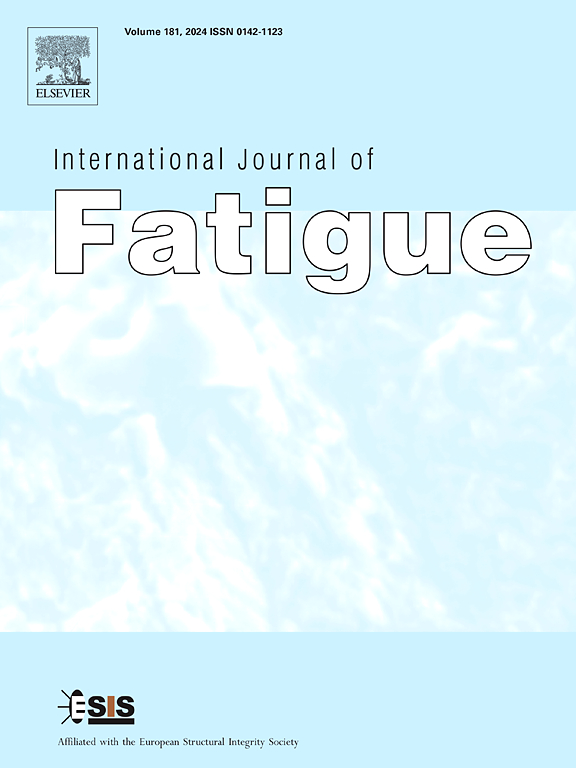采用多轴疲劳框架研究界面接触和损伤梯度对ti - 6al - 4v燕尾组件微动疲劳的影响
IF 5.7
2区 材料科学
Q1 ENGINEERING, MECHANICAL
引用次数: 0
摘要
在本研究中,对燕尾组件进行了微动疲劳试验。采用数字图像相关(DIC)设备记录了构件在试验过程中的位移和应变。结果表明,燕尾组件逐渐出现粘接现象,在大约10,000次循环后趋于稳定,相对滑移比初始循环显著减少。同时还监测了表面磨损和温度。结果表明:在微动试验过程中,接触区积累了大量磨损碎屑,增加了摩擦系数,加剧了粘着现象;这导致了摩擦能的减少,使表面温度的变化最小。因此,对于燕尾组件的微动疲劳,局部应力集中成为影响疲劳寿命的主要因素,超过了相对滑移、表面磨损和摩擦热产生的影响。建立了燕尾组件有限元模型,结合Chaboche材料本构模型,计算了循环加载下燕尾组件的稳定应力应变分布。根据DIC测试结果验证了模型的预测。基于已建立的多轴疲劳框架,开发了对仿真结果进行后处理的程序,生成了临界角和损伤分布图。针对局部损伤梯度的特点,提出了一种选择临界距离并进行损伤梯度校正的方法。该方法成功地应用于SWT和FS模型,证明了良好的有效性。本文章由计算机程序翻译,如有差异,请以英文原文为准。
The effect of interfacial contact and damage gradient on fretting fatigue of Ti-6Al-4 V dovetail assembly using a multiaxial fatigue framework
In this study, fretting fatigue tests were performed on dovetail assemblies. The displacement and strain of the components during testing were recorded using Digital Image Correlation (DIC) equipment. The results revealed that the dovetail assembly gradually exhibited a sticking phenomenon, stabilizing after approximately 10,000 cycles, with relative slip significantly reduced compared to the initial cycles. Surface wear and temperature were also monitored. The findings showed that during the fretting tests, a considerable amount of wear debris accumulated in the contact zone, increasing the coefficient of friction (COF) and intensifying the sticking phenomenon. This led to reduced frictional energy, causing minimal changes in surface temperature. Consequently, for fretting fatigue in dovetail assemblies, localized stress concentration emerged as the primary factor affecting fatigue life, surpassing influences from relative slip, surface wear, and frictional heat generation. Additionally, a finite element model of the dovetail assembly was developed, incorporating the Chaboche material constitutive model to calculate the stable stress–strain distribution under cyclic loading. The model’s predictions were validated against the DIC test results. Based on an established multiaxial fatigue framework, a program was developed to post-process the simulation results, producing diagrams for critical angles and damage distribution. To address the characteristics of local damage gradients, a method for selecting the critical distance and applying damage gradient correction was proposed. This approach was successfully applied to the SWT and FS models, demonstrating excellent validation.
求助全文
通过发布文献求助,成功后即可免费获取论文全文。
去求助
来源期刊

International Journal of Fatigue
工程技术-材料科学:综合
CiteScore
10.70
自引率
21.70%
发文量
619
审稿时长
58 days
期刊介绍:
Typical subjects discussed in International Journal of Fatigue address:
Novel fatigue testing and characterization methods (new kinds of fatigue tests, critical evaluation of existing methods, in situ measurement of fatigue degradation, non-contact field measurements)
Multiaxial fatigue and complex loading effects of materials and structures, exploring state-of-the-art concepts in degradation under cyclic loading
Fatigue in the very high cycle regime, including failure mode transitions from surface to subsurface, effects of surface treatment, processing, and loading conditions
Modeling (including degradation processes and related driving forces, multiscale/multi-resolution methods, computational hierarchical and concurrent methods for coupled component and material responses, novel methods for notch root analysis, fracture mechanics, damage mechanics, crack growth kinetics, life prediction and durability, and prediction of stochastic fatigue behavior reflecting microstructure and service conditions)
Models for early stages of fatigue crack formation and growth that explicitly consider microstructure and relevant materials science aspects
Understanding the influence or manufacturing and processing route on fatigue degradation, and embedding this understanding in more predictive schemes for mitigation and design against fatigue
Prognosis and damage state awareness (including sensors, monitoring, methodology, interactive control, accelerated methods, data interpretation)
Applications of technologies associated with fatigue and their implications for structural integrity and reliability. This includes issues related to design, operation and maintenance, i.e., life cycle engineering
Smart materials and structures that can sense and mitigate fatigue degradation
Fatigue of devices and structures at small scales, including effects of process route and surfaces/interfaces.
 求助内容:
求助内容: 应助结果提醒方式:
应助结果提醒方式:


